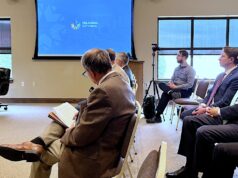

All you need is love, or at least information.
The Council on American-Islamic Relations chapter of Oklahoma (CAIR-OK) released its Educator’s Guide to Islamic Religious Practices earlier this month in an effort to increase understanding of Islam and Muslim students in Oklahoma schools.
The document’s release comes at a time when tensions surrounding Islam in the Sooner State seem to be at their highest.
Recent history of Islamophobia in Oklahoma
In June, Oklahoma Rep. Pat Ownbey (R-Ardmore) stated he was uncertain if Islam, the world’s second-largest religion, deserved protection under the First Amendment.
Months later in October, Oklahoma Rep. John Bennett (R-Sallisaw) brought even more overt anti-Islamic sentiments to the Oklahoma State Capitol. He held a hearing during which he labeled local Muslim leaders as terrorists and demanded that they not be hugged.
But perhaps the most striking recent example of open Islamophobia in Oklahoma came from Dan Close, a Dewey High School teacher, who encouraged his Facebook followers last summer to vote for Donald Trump if “you want (Muslims) butchered.”
One wonders if Close’s blunder inspired CAIR-OK leaders to publish its educator’s guide, or at least contributed to the decision to do so.
The educator’s guide
CAIR-OK’s educator’s guide contains 14 pages of practical information and explanations of religious requirements and customs that many Muslim students in Oklahoma public schools follow.
The guide covers topics such as dietary restrictions, gender relations, holidays, daily prayers and fasting during the month of Ramadan.
The information conveyed in the guide’s pages is by no means new, but it does highlight the key points in a concise format that educators would benefit from knowing.
It also contains at least one fact I did not previously know — Dijon mustard contains white wine. After much research, I can relay that conflicting reports exist regarding the alcohol content of Grey Poupon.
‘A much-needed launching point’
In the case of Ownbey, when he was asked by NonDoc if he knew whether Ardmore had an active mosque, the town’s state representative admitted he wasn’t sure. In the weeks following, NonDoc learned that Ownbey had met with Muslim leaders for a positive discussion.
The Ownbey scenario highlights what should be an obvious truth: It’s easy to hate something or someone you don’t know. That axiom holds whether in reference to refugees from largely Muslim countries or to discrimination and bigotry in Oklahoma. Any time or effort spent getting to know your neighbors, their values and beliefs will go a long way toward bridging a growing gap.
In a world in which walls are built and contrast seems to overshadow commonality, it’s about time teachers have a tool to understand more about a growing proportion of their students.
With that said, it’s important to keep in mind that customs may differ in the Muslim world, and among Muslim students. Not every Muslim student will follow every custom highlighted in the guide, nor does the guide contain every custom that might be followed.
The educator’s guide should not be seen as a rule book that governs the absolute requirements of every Muslim student.
Rather, it should be taken as a much-needed launching point for teachers to begin an open and honest conversation with their students.
